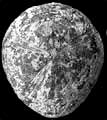The Echinoid Directory
Heterobrissus Manzoni & Mazzetti, 1878, p. 354
[=Archaeopneustes Gregory, 1892, p. 163, type species Paleopneustes hystrix Agassiz, 1880; ?=Brissolampas Pomel, 1883, p. 31, type species Palaeopneustes conicus Dames, 1877; ?=Pygospatangus Cotteau, 1888, type species Pygospatangus salvae Cotteau, 1877 ]
| Diagnostic Features |
|
|---|---|
| Distribution | Oligocene, Puerto Rico, Miocene, Italy, Cyprus; Recent, Indo-Pacific and Caribbean. |
| Name gender | masculine |
| Type | Heterobrissus montesi Manzoni & Mazzetti, 1878, p. 354, by original designation. |
| Species Included |
|
| Classification and/or Status |
|
| Remarks |
|


